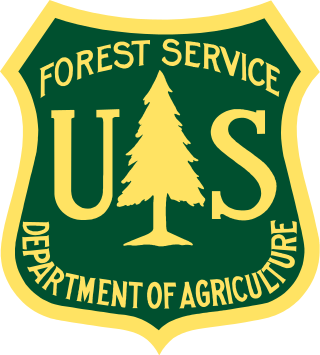
The United States Forest Service (USFS) is an agency within the U.S. Department of Agriculture that administers the nation's 154 national forests and 20 national grasslands covering 193 million acres (780,000 km2) of land. The major divisions of the agency are the Chief's Office, National Forest System, State and Private Forestry, Business Operations, as well as Research and Development. The agency manages about 25% of federal lands and is the sole major national land management agency not part of the U.S. Department of the Interior.

In the United States, national forest is a classification of protected and managed federal lands that are largely forest and woodland areas. They are owned collectively by the American people through the federal government and managed by the United States Forest Service, a division of the United States Department of Agriculture. The U.S. Forest Service is also a forestry research organization which provides financial assistance to state and local forestry industry. There are 154 national forests in the United States.
The Department of State Lands (DSL), one of the oldest agencies of government of the U.S. state of Oregon, is principally responsible for the management of lands under state ownership, as its name implies. Unlike most other department-level state agencies, it is not headed by a sole elected official, but is the administrative arm of the Oregon State Land Board. Although established by the Constitution, subsequent statutes have added to its duties and authority, and include some provisions relating to its conduct. In addition to managing state-owned lands, the Board through the Department is responsible for the Common School Fund, off-shore lands and coastal estuarine tidelands, submerged and submersible lands of the navigable waterways, unclaimed property, estates with no heirs, and additional functions assigned by the Oregon Legislative Assembly from time to time. The Board decides cases, adopts rules, issues policy statements, and approves DSL recommendations.

Forestry Tasmania trades as Sustainable Timber Tasmania but is still legally called Forestry Tasmania. It is a government business enterprise wholly owned by the Government of Tasmania, Australia. It is responsible for the management of public production forest in Tasmania, which is about 800,000 hectares of crown land that is classified as 'permanent timber production zone'.

The Sustainable Forestry Initiative (SFI) is a sustainability organization operating in the U.S. and Canada that works across four pillars: standards, conservation, community, and education. SFI was founded in 1994 by the American Forest & Paper Association (AF&PA). SFI is the world's largest single forest certification standard by area. SFI is headquartered in Ottawa and Washington, D.C.

Land use in Oregon concerns the evolving set of laws affecting land ownership and its restrictions in the U.S. state of Oregon.
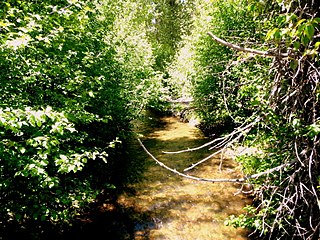
Sun Pass State Forest is one of six state forests managed by the Oregon Department of Forestry. The forest is located 40 miles (64 km) north of Klamath Falls, Oregon near the southeastern corner of Crater Lake National Park. It is the largest single block of Oregon state forestry land east of the Cascade Mountains. The forest is managed as part of the Klamath-Lake District, comprising 21,317 acres (86.27 km2) of the 33,739 state-owned acres within the district.

The Oregon Board of Forestry is responsible for forest policy and oversight of forest management practices within the state of Oregon. The board appoints the state forester and oversees the Oregon Department of Forestry. The board also works with private land owners and the Federal Government to promote consistent forest management policies throughout the state.

Santiam State Forest is one of six state forests managed by the Oregon Department of Forestry. The forest is located approximately 25 miles (40 km) southeast of Salem, Oregon, and includes 47,871 acres (193.73 km2) on the western slope of the Cascade Mountains in three Oregon counties: Clackamas, Linn, and Marion. It is bounded on the east by the Willamette National Forest and Mount Hood National Forest. Silver Falls State Park is located west of the forest. The rest of the land surrounding the forest belongs to the Bureau of Land Management or is privately owned. The forest is managed as part of the Department of Forestry's North Cascade District.

Tobias Read is an American politician who is the current Oregon State Treasurer. He was a member of the Oregon House of Representatives, representing District 27 from 2007–2017, which comprises parts of Beaverton, southwest Portland, and unincorporated Multnomah and Washington Counties. He served as Speaker Pro Tempore and was formerly the Democratic Majority Whip.
The Montana Legacy Project is a three-phase purchase of more than 310,000 acres (1,300 km2) of land owned by Plum Creek Timber in northwestern Montana for conservation protection. The land is within the counties of Missoula, Mineral, Lake and Powell.

Gilchrist State Forest is the sixth and newest state forest in the U.S. state of Oregon. The forest is located in northern Klamath County near the community of Gilchrist and was officially dedicated on June 11, 2010. The forest sits along U.S. Route 97 and is 70,000 acres (28,000 ha) in size.
The Coos Bay Wagon Road Lands is land managed by the United States Bureau of Land Management. The land was originally granted to the Oregon & California Railroad to create a road between Coos Bay, Oregon, and Roseburg, Oregon. The land was reconveyed to the United States in 1937.
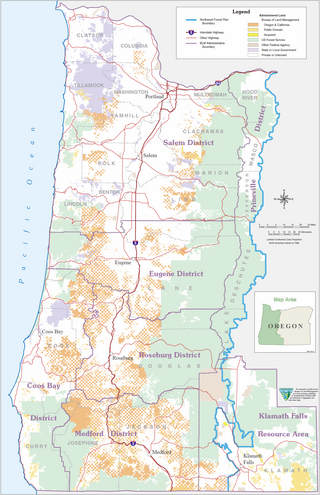
The Oregon and California Railroad Revested Lands, are approximately 2,600,000 acres (1,100,000 ha) of land located in eighteen counties of western Oregon. Originally granted to the Oregon & California Railroad to build a railroad between Portland, Oregon and San Francisco, California, the land was reconveyed to the United States government by act of Congress in 1916 and is currently managed by the United States Bureau of Land Management.
State trust lands were granted by the United States Congress to states upon entering the Union. These lands were designated to support essential public institutions which are primarily public schools. State trust land managers lease and sell these lands to generate revenue for current and future designated beneficiaries. Predominantly found in the western United States, 46 million acres of land are currently designated as trust lands and the proceeds from the lease and sale of these lands are distributed into a state's permanent fund and used for many purposes.

The Barry Point Fire was a wildfire that burned over 92,977 acres (376.26 km2) of Oregon and California forest land during the summer of 2012. The fire began on 5 August 2012, the result of a lightning strike. The fire consumed public forest and rangeland as well as private forest and grazing land located in Lake County, Oregon and Modoc County, California. The public lands effected by the fire are administered by the United States Forest Service and the Oregon Department of Forestry. The largest part of the private land was owned by the Collins Timber Company. At the peak of the firefighting effort, there were 1,423 personnel working on the fire. It took 22 days to fully contain the fire and then an additional three weeks to mop it up.
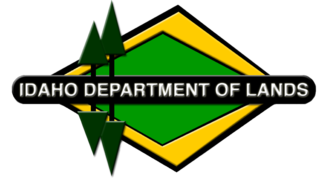
The Idaho Department of Lands (IDL) is a state-level government agency of Idaho that manages State Trust Lands. IDL oversees forestry practices on state lands and some regulation of mining practices, as well as administering forestry programs and providing fire protection and prevention on state lands. IDL operates under the Idaho State Board of Land Commissioners and is the administrative arm of the Idaho Oil and Gas Conservation Commission.
The Southeast Alaska Conservation Council (SEACC) is a non-profit organization that focuses on protecting the lands and waters of Southeast Alaska. They promote conservation and advocate for sustainable natural resource management. SEACC is located in the capital city of Alaska, Juneau. The environmental organization focuses on concerns in the Southeast region of Alaska, including the areas of the Panhandle, the Tongass National Forest, and the Inside Passage.
The Victorian Plantations Corporation (VPC) of Victoria, Australia, was established under the State Owned Enterprises Act in May 1993, and by June 1993 was declared a State Business Corporation.
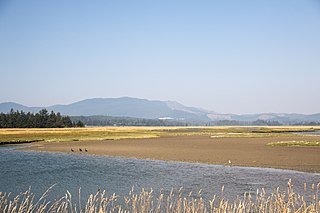
Sitka Sedge State Natural Area is an estuary and beach on the north coast of the U.S. state of Oregon in Tillamook County. Sitka Sedge consists of 357 acres (144 ha) of tidal marsh, mudflats, dunes, forested wetlands, and uplands at the south end of the Sand Lake estuary, north of Tierra Del Mar.















